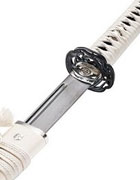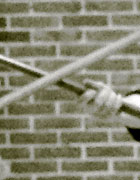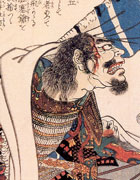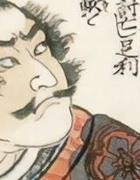
Literally the term means “the life-giving sword” or “the animating sword”. However, it does not so much refer to the physical sword as to swordsmanship. The concept is the opposite of setsunin-tõ: “the killing [life-taking] sword [swordsmanship]”.
Around 1600 these concepts received a second (spiritual and philosophical) meaning in the Yagyu Shinkage Ryu, which was strongly influenced by Zen Buddhism. Katsujin-ken now also referred to the sword that animates the sword fighter. Setsunin-tõ, the killing sword, is of a lower order than the sword that keeps alive, or gives life to, the adversary – not just from a strategic point of view (see below), but also from a Buddhist perspective.
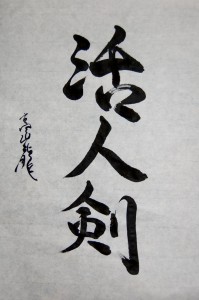
Artwork by cathexis_life
At the same time the terms keep their meaning on the level of physical confrontation of the older schools. Yagyu Muneyoshi says: in our school the sword that is positioned for attack is called “setsunin-tõ”; the sword that isn’t is called “katsujin-ken”. (Hiroaki Sato, The Sword & The Mind, Woodstock, N.Y.: Overlook Press, 1986: p. 81 details…). And in his study of the Kashima Shin-ryu Karl Friday makes the following comment:
“In classical bugei [traditional Japanese military arts] parlance, however, the connotations are more concrete: The “sword” in both cases refers not to the weapon itself but to its usage; and it is not the opponent himself who is killed or given life, but his responses and fighting spirit. When a combatant uses force of will to overpower, immobilize, and strike down an opponent before he can react, this is called “setsunin-tõ” (i.e. “sword[smanship] that transfixes”, or ‘swordsmanship that kills response”). “Katsujin-ken” (“Sword[smanship] that animates”), on the other hand, involves drawing out the opponent, inducing him to strike, and then going inside his technique, countering it either at the moment of origination or at the point of its most complete extension. Setsunin-tõ is an egoistic and risky approach to combat – the slightest miscalculation will result in the swordsman walking straight into the opponent’s counterattack. Katsujin-ken, by contrast, involves a sophisticated manipulation of the opponent and his actions by means of utter selflessness, properly conducted, it is virtually undefeatable.”
(Karl F. Friday, Legacies of the Sword: The Kashima-Shinryu and Samurai Martial Culture, Honolulu: University of Hawai’i Press, 1997: p. 31. details…)
When studying traditional Japanese sword fighting it is important to realise that different interpretations of terms and techniques can be made on different levels (physically, communicatively. spiritually; or self-development, personal interaction, transcendence) and that they do not exclude but complement each other.
Stephen Snelders
